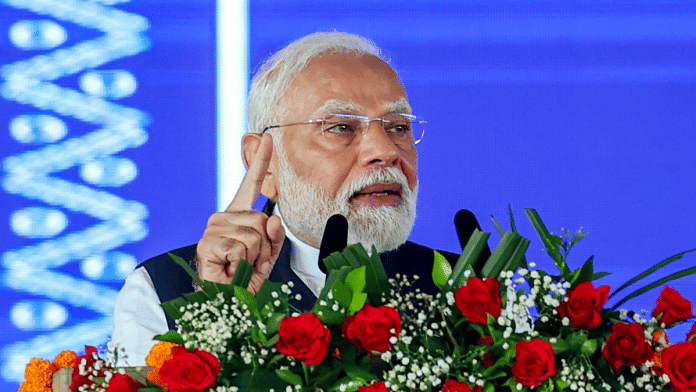As Maharashtra approaches assembly elections, Prime Minister Narendra Modi’s slogan “Ek hai toh safe hai (We are safe if we are united)” resonates across the political landscape in the state. It strikes a chord with both political campaigns and trending discussions on X. Amid global and domestic debates, the message underscores the importance of unity while challenging divisive practices aimed at political fragmentation. It’s not just an election call but is rooted in the philosophies of historical figures such as Chhatrapati Shivaji, Lokmanya Tilak, and MK Gandhi, each of whom championed unity as essential to resisting oppressive rule.
The importance of unity has always been emphasised throughout Indian history, particularly during periods of intense strife and division. In the 17th century, Shivaji unified the Maratha regions, expounding the idea of Hindavi Swarajya (self-rule). For Leftist historians, it was just a rebellion. Shivaji’s Swarajya was a mass movement that united the 12 mavals (the 12 regions of the Western Ghats) and the 12 balutedars (the traditional village-level socio-economic framework). It undermined local feudal lords and prepared the masses for a long fight against the tyrannical Sultanates. Shivaji’s vision galvanised these communities—comprising various social and economic groups—into a cohesive force, instilling a sense of cultural confidence and the belief that the masses could establish their own governance, rule, and king. This movement not only challenged oppressive regimes but also fostered a shared identity rooted in self-rule and collective strength. This inclusivity strengthened Shivaji’s kingdom and served as a model for resisting divisive tendencies, emphasising that unity—both geographical and social—is the foundation of a resilient state.
Similarly, Tilak and Gandhi rallied around the idea of swarajya to unite India’s diverse populations into a mass movement against British. They emphasised unity among the masses, recognising that collective strength was essential to dismantle the colonial “divide and rule” strategy, which sought to exploit India’s diversity to weaken its resistance. Their efforts went beyond the goal of political independence, instilling a sense of shared purpose and preparing the masses for a long struggle toward self-governance and democracy. By transcending barriers of caste, creed, and religion, they fostered a collective identity that empowered the people to envision and fight for a future rooted in freedom and democratic values.
Also read: Indian politics is going back to the pre-2014 era. What this means to Brand Modi and BJP
A new concept of unity
Today, Modi’s “Ek hai toh safe hai” echoes this historical call for unity, challenging divisive vote-bank politics and the Leftist-purogami narratives that focus narrowly on identity-based fragmentation. While the concept of unity in diversity emphasises India’s varied identities, it often stops short of reinforcing the foundational unity that binds the country together. By emphasising “diversity in unity”, Modi’s slogan advocates for an inclusive national identity that celebrates diversity within a unified whole. This approach asserts that unity is the foundation upon which diversity thrives—a concept crucial to sustaining India’s unique identity. India’s cultural integrity is like a flower — vibrant and fragrant when its petals are intact. When Leftists and their new avatar, the Urban naxals, strategise to separate these petals by isolating and creating new identities, the flower withers, losing both its beauty and strength. This deliberate fragmentation risks reducing India to competing groups rather than a cohesive whole, undermining the unity that allows diversity to thrive. Their divisive tactics aim to exploit differences, dismantling the collective strength that has historically been India’s foundation.
In today’s Maharashtra, politics is deeply entrenched in sectarian, caste, and linguistic divides. The Sharad Pawar-led Nationalist Congress Party (NCP) has often been associated with Maratha-identity politics, while Uddhav Thackeray has leaned on the “Mumbai card” to consolidate his base. The state has witnessed prolonged and noisy protests over Maratha reservation demands, which were first raised in 1983. For nearly three decades thereafter, despite Sharad Pawar and Congress being in power either as CM or kingmakers, the issue saw no significant progress. Yet, these protests were weaponised against the Bharatiya Janata Party (BJP) government in the state. Against this backdrop, PM Modi’s slogan gains crucial relevance.
In Maharashtra, where Shivaji’s legacy continues to inspire, “Ek hai toh safe hai” reminds the people to transcend the divisions and embrace a unity that respects diversity without undermining it. Modi’s call encourages voters to resist strategies that reduce India’s unity to fragmented identities. In essence, it is more than a slogan—it is a modern reflection of the idea of Swarajya, rooted in unity as the foundation of strength, security, and progress. This rallying cry underscores that India’s unity is its greatest strength, a legacy that has endured despite external and internal attempts at fragmentation. Just as the petals of a flower, when held together, create something beautiful and meaningful, so does India’s diversity find its fullest expression within the framework of a unified nation.
Abhishek is pursuing a Mid-Career degree at the Harvard Kennedy School. Views are personal.
(Edited by Humra Laeeq)






